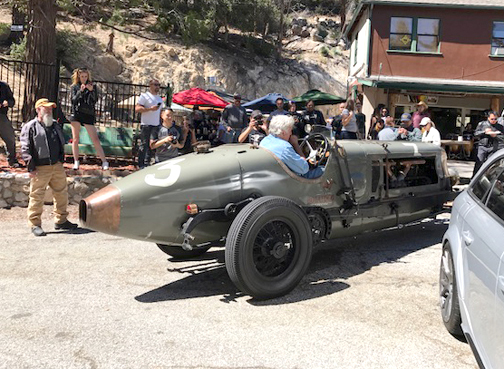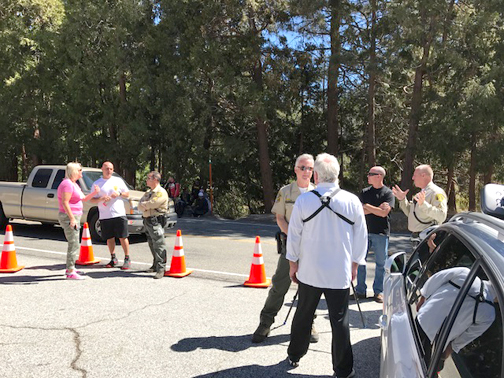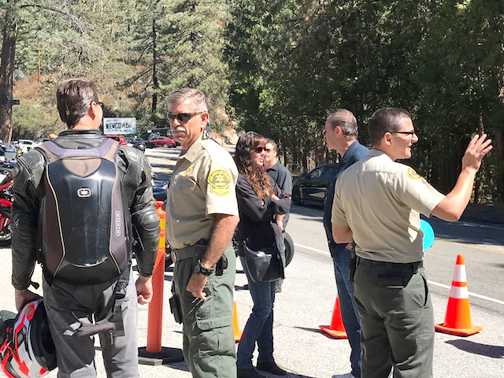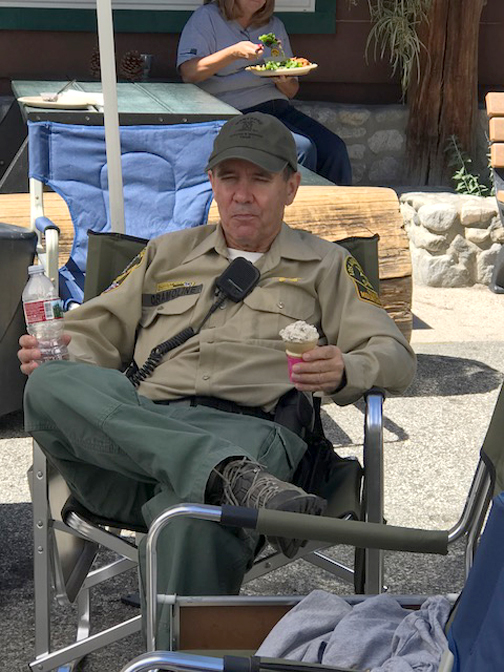
Hundreds of supporters of the Montrose Search and Rescue team, eager to help the team celebrate 70 years of service, stopped by Newcomb’s Ranch on Sunday.
By Mary O’KEEFE
On Sunday, Montrose Search and Rescue celebrated 70 years of service at Newcomb’s Ranch in the Angeles National Forest along with motorcycles, classic cars, team members, their family and friends.
MSAR is a volunteer organization that patrols the ANF every weekend, responds to calls of help that, at times, can reach across the state, and is always ready to support the community.
Team members are trained and managed by the Los Angeles County Sheriff’s Dept. Members were at Newcomb’s on Sunday in force and, at their side, as always, were their spouses and families.
CVW often writes about MSAR call-outs; however, there is another important aspect of the team – the members’ families.
“He has been with Montrose Search and Rescue for 10 years and previously he was with Sierra Madre Search and Rescue for about 10 years,” said Suzy Sheedy about her husband Robert who is the MSAR team leader.

Suzy is used to her husband being on-call and is proud of what he does, but those call-outs do not recognize holidays or anniversaries.
“I do plan. We have holiday [plans], but I always have a Plan B in the back of my mind just in case he won’t be there,” she said. “This Fourth of July we had about 50 people at our [home] and about 15 minutes into the party he got a call and left. We just kind of carry on. I had the kids and friends and they know what the deal is.”
Suzy knows how important these call-outs can be – rescuing lost hikers, responding to cars over the side and recovering bodies – to help give much-needed closure to families. And although it takes some planning, she works around this constant on-call service.
“I would never say [to him], ‘You cannot leave.’ If I would say, ‘No, you can’t do that,’ I would have a very unhappy camper at home,” she joked.
She said Robert’s service is a sense of pride for her and often people are amazed when they find out the amount of time the MSAR members put into the team, not just responding to calls but training as well.
Her advice for families of new members of the team is to plan a project when the team is gone on training.
“Every time Robert has a training weekend or training days, I always have a project at home like painting a room or cleaning out a closet or have something to do with my girlfriends,” she said.
Keeping busy with projects of her own has helped her when the training days, weekends or weeks have stretched out over the years.
There are those midnight calls, though, when the team will be hiking down a cliff and into the forest that could cause concern, but Suzy says she does not really worry.
“I know he couldn’t be with a better group of men and women who are trained to rescue so I figure if he gets himself into a bind, who better to be with him than his [his team members]? So I don’t really worry. It took a while for me to let that go, though, but now I let it go and figure all is well. I can tell you – if I were in the mountains and I was in trouble I would want them to come after me.”
She added these are men and women who are making little to no money; they get $1 a year.
“They are helping from the heart,” she said.
At this point in time, Nancy Leum could be considered an MSAR family expert. Her husband, Mike, has been on MSAR for 25 years – that’s 25 years of 24/7 on-call service. She has seen anniversary plans change and is used to the pager going off at all hours of the day and night.
“At the beginning, you find out everything that is involved in being [a member of MSAR] with the training and patrols, and it can be overwhelming,” Nancy said of becoming part of the MSAR family.
But, like Suzy, she sees this as a calling for her husband and understands the importance of this work.
“I feel strongly about what he does, too,” she said. “I would never say, ‘You shouldn’t go.’”
She, too, always has a Plan B for family events.
“If you have a plan for the day and his pager goes off, you go to Plan B,” she said.
Her advice to new family members is to be part of the support for MSAR. She would often take the couple’s two boys to training days or meet Mike when he had a break while patrolling ANF.
The Leums really do have a team feeling about MSAR. Nancy makes sandwiches whenever Mike is on patrol or is on a call-out. There have been numerous times when Mike and the team have found hikers who are cold and very hungry. The “Nancy sandwiches,” as Mike calls them, are always on hand and always welcomed.
This is a contribution she can make to the team.
“It is important to get involved with the team,” she said. “I will go with him when he is packing up for his winter training. I like the feeling of being involved.”
Nancy added that the team is a family and that often when members are out on a search she stays in touch with Suzy and other spouses. And, like Suzy, she is confident in the team’s training and their support for one another and knows if he gets into a situation where he needs help there is no one better than a member of the MSAR team to be there with him.
“It’s nice. [The families] are close. We will [contact] each other to see who has heard from whom on the team,” Nancy said. “Mike is really good about [updating her]. If he is going to be late, I will get a call from him or someone on the team to let me know.”
So getting involved, having a project and having a Plan B are all good advice for new members like Collin Lievense, the newest MSAR member.
He joined the team in April 2014 but had known about MSAR for years before thanks to Boy Scouts.
“I was a Boy Scout and an Eagle Scout and knew of MSAR then because they had helped [my troop],” Lievense said. “I always had a big interest in doing what they did.”
After he joined the team, he found out that MSAR had rescued his uncle before Lievense was born.
He said the training to become a member is difficult but he did know some of the training exercises, like tying knots used on ropes for going over the side of a mountain.
“There was a lot involved and, coming from an Eagle Scout [background], I knew a lot of the knots before. But doing them upside down in the dark while its raining and your hands are cold … that’s a different story,” he said.
From the time he showed interest in joining the team to being accepted was about two years, but Lievense had followed the team long before and got to know what they did before deciding to join.
“I always thought of these [MSAR members] as top of the pedestal but didn’t realize the extent of what they do to help the community. I didn’t realize every single weekend they are out there [in the ANF] helping drivers of motorcycles that crashed and people who are lost – people get lost a lot more than you would think. And cars going over the side of the mountain; there seems to be an increasing number of those calls,” he said.
When asked what his most memorable rescue or response has been thus far, he replied there have been some that did not have a happy ending.
“There are a lot of sad rescues that stand out. But one of the more happy ones was a family that had gone out hiking. It was a father, son and two friends and they were lost in the [forest]. We had hiked all night, from sunset to sunrise, and we found them.”
It is an amazing feeling when, after hiking all night, you finally find the lost hikers, he said.
“The girl came up and hugged us and right away you get this feeling that you know you made a difference,” Lievense said.
Because MSAR is a volunteer team, members have day jobs, most with understanding bosses. Lievense works at Jet Propulsion Laboratory.
“Luckily, the majority of the calls are at nights and on weekends. It is easy to make most of those calls. My workplace is very accepting. I told them about my involvement with MSAR before I was hired and they are very supportive,” he said.
Dan Hensley has been on MSAR for 53 years. He is a retired schoolteacher and he too had an understanding boss, at least for a while.
“I had a unique situation. The principal I worked for had been converted by the Sierra Madre Search and Rescue team so he was supportive,” Hensley said.
The principal made a deal with Hensley that if he was called out and was out most of the night the principal would cover his classroom until noon. This allowed him to get sleep. And if he was called out during the day, the principal would cover his class.
“I had that arrangement for a number of years,” he said.
But then one day the principal called him into the office and said he could no longer cover his classroom.
“I was surprised. He said he had no idea ‘you guys did that much work,’” Hensley said.
Shortly after the end of the arrangement, Hensley got a call-out in the middle of the day. A Los Angeles school bus had allegedly gone over the side of ANF with a bus load of kids. He left and got into some trouble, but didn’t care.
“It turned out that call was a hoax, but hoax or not, kids in trouble verses staying at my job … it doesn’t equate,” he said. “I was going to go,”
Hensley had a history of rescues and responding to emergencies.
“I had been on two other rescue teams before I joined [MSAR],” he said. “I have been blessed; my community has taken care of me when I was a little kid, made it possible for me to get an education. My parents told me that at some point I would grow up and have to pay it back, so this a way to pay back.”
A lot of his training came from the U.S. Forest Service.
“I was a smoke jumper in Montana,” he said.
Smoke jumpers were those early firefighters who would jump out of planes to get to a forest fire. During this time he was trained as a paramedic.
“That was before there were paramedics. We were trained with the U.S. Air Force program,” he said.
When asked to share his most memorable response, he paused.
“Well, you know the one for me was the most tragic. It was during the 1969-1970 floods when we lost Foothill Boulevard and the bridge [in Big Tujunga Canyon]. The bridge had been washed out and people were on the other side of the creek in Big Tujunga Canyon,” he said.
The MSAR team was tasked with getting the people who were trapped on what was now an island over to the land side.
“The people couldn’t get to school and those who had left [before the flood] couldn’t get back home,” he added.
MSAR divided into two teams to find a way across the raging creek.
“There were a lot of islands and what we were doing was island hopping … We would chop down a tree, it would land on an island, we would cross and chop down another tree, cross to another island [and so on]. On the third island we got word that the other team had made it to the [stranded [people],” he said.
Hensley and his team were told to go back to join the other team. The rain continued and the creek continued to rise. A tree they had used to get over one of the islands had been about two inches or more above the water when they had crossed just a few moments earlier, but now it was two feet under water.
“In coming back, one of our team members had [fallen into the creek],” he said.
Reserve Deputy Charles Rea had connected his safety harness to a hand line and had begun walking across the raging water on a log when he slipped.
“He fell on the top side of the log and was tethered,” Hensley said.
Rea had fallen off the upper side of the log and the water pushed him under, his rope still tethered. Team members grabbed him and tried to pull him up, but the current was too strong.
“It took him under,” Hensley recalled.
The water continued to rise and the team members could not recover Rea’s body that night. They went back the next day to recover one of their own.
“It took nine of us to pull him out,” Hensley said.
He said that if Rea hadn’t been tethered, he may have been able to make it to shore but the water was so treacherous.
“There were boulders the size of Volkswagens going down the [creek],” he said.
The MSAR captain spoke at Rea’s funeral.
“He said if anyone thinks this is going to stop us from doing our job, they are wrong. We are still going to do our job, but that doesn’t mean we weren’t affected by [this loss],” he said.
Hensley’s advice for those who are just starting out with MSAR?
“You are with a bunch of dedicated, highly-trained people. Listen to them. They are going to do a lot of good for a lot of people for a long time.”
The fundraiser on Sunday raised about $15,000. These funds will help pay for the equipment each member is required to purchase.
There are still MSAR shirts available for $20 each at the Crescenta Valley Sheriff’s Station. Anyone who would like to support MSAR and donate can do so by dropping off a donation at the front desk of the CV Sheriff’s Station, or mail a check to the attention of Dep. Jeff Martin to 4554 Briggs Ave., La Crescenta, CA 91214. Checks can be made out to Montrose Search and Rescue.










